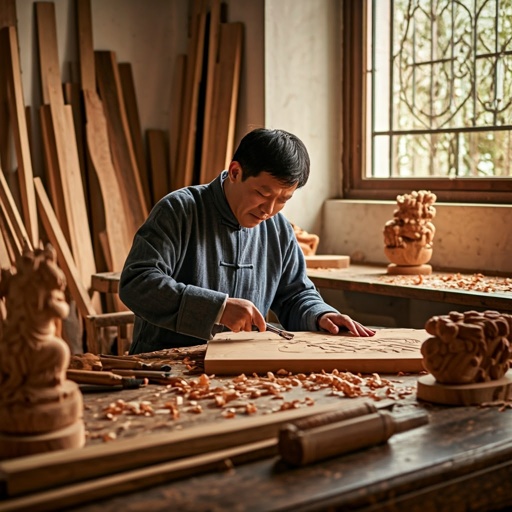Jenny Hall
Verses from the Dhammapada 160
Who is the Master of Self?
We are led to believe that if we strive long and hard enough, it is possible to be ‘master of the self’... The idea that it is persistent in time is false. Everything, including me, is in a state of flux. I am at best no more than a constantly changing thought stream driven by strong emotions such as desire and hatred.

Chinese Woodcarver
Shutterstock
“Who else but the Self can be master of the self”?
This verse points to Choiceless Awareness, (the Self with a capital ’S’).
From early childhood, we are encouraged to control our impulses in order to improve ourselves. We learn to restrain our negative qualities and to express the positive. We are punished or rewarded accordingly. We are led to believe that if we strive long and hard enough, it is possible to be ‘master of the self’. This self (with a small ’s’) tends to be regarded as a stable, permanent entity. Through time and training, we believe that the self can become a ‘good’ person, admired and respected.
However, the Buddha taught that this ‘self’ is actually a delusion. The idea that it is persistent in time is false. Everything, including me, is in a state of flux. I am at best no more than a constantly changing thought stream driven by strong emotions such as desire and hatred.
The Buddha also pointed out that, contrary to belief, the ‘I’ is not in control of these thoughts and emotions. It is incapable of becoming their master. What we imagine is restraint is often no more than repression.
How often have we ignored simmering irritation, believing we are stoically putting up with a situation when suddenly, much to everyone’s surprise, we find ourselves blurting out a grievance.
When we first sit zazen, it soon becomes obvious that ‘I’ cannot control thoughts. They think themselves. All this makes the ‘I’ secure and leads to constant efforts to bolster itself up. It chases after relationships, objects and situations. By such means it hopes to find fulfilment. However, even if we do succeed in acquiring what we have striven for, we become attached and we then suffer when it inevitably changes or disappears. To escape such suffering, we may adopt certain practices that we believe will lead us to enlightenment. However, all that is happening is that the idea of ‘me’ is becoming more and more entrenched.
“Who else but the Self can be the master…”?
In Zen training we are told that we have to abandon all such ideas of achieving something or of getting somewhere. We are constantly told to ‘look where your own feet stand’. This involves wholeheartedly giving ourselves away into whatever is arising.
This exactly mirrors Timothy Gallwey’s instructions in his book, The Inner Game of Golf. He points out that the way most of us learn to control our bodies doesn’t work. When we tell ourselves to do something we become clumsy and self-conscious. Our self- interference sabotages performance. What is important is being aware of what the body is actually doing.
Rather than giving a player a set of verbal instructions, Gallway would perhaps say, “As you hit the ball be aware of what your left shoulder is doing”. The mind naturally quietens and awareness achieves the desired result.
Such effortless action is illustrated in the story of the woodcarver Qing. He was commissioned by the ruler of China to carve wooden stands for sets of bronze bells. When they were finished everyone was amazed by the exquisite workmanship. The ruler praised their beauty and asked Qing about the technique he used. Qing said he did nothing special. When pressed further, Qing said that before carving he fasted for seven days. After the first three days, he became detached from praise or reward. After five days, all thought of blame and clumsiness disappeared. After seven days, his mind was completely still. All distractions, including the sense of his body had fallen away. Qing said he was then ready to start work. He then set off for the mountains to look at trees. If he saw a perfectly shaped tree, he was able to see the completed bell stand within it. He said all he had to do was to allow his hand to begin carving.
When we embark on the Zen training we also have to turn inwards in order to become familiar with the emotional energy. When we befriend it, and ask its hot flames to burn me away, the ground of our being (the Self) opens. This is the spaciousness of Choiceless Awareness which self- consciousness has obscured. From that open heart compassion flows for the good of all.
For many months, the children in the Close were constantly breaking the branches of a lovely cherry tree. They had been asked not to do it many times but to no avail. One afternoon they were taking turns to climb up the tree and shake all the blossom off.
Meeting the irritation that arose, it was realised that another approach was required. Gathering the children around I said I hadn’t come to tell them off. Would they like to hear a true story? I told them of two neighbours who used to live in the close. They were best friends. One of them become very ill and died. His friend was very sad. He planted the cherry tree in remembrance of him. We all love the tree very much and try to take care of it. From that day the children have shown only respect for the tree.
We don’t have to follow rules to be compassionate. We just have to listen to the open heart.
Lao Tsu asked: “Can you remain tranquil until right action occurs by itself?”




